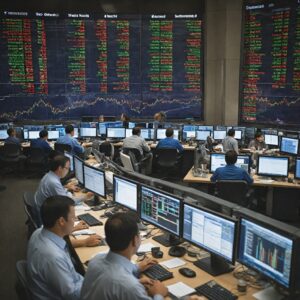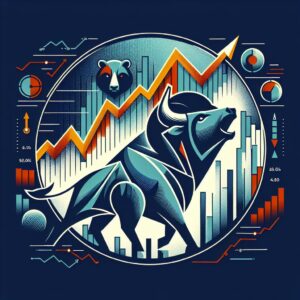Summary
The article “Unsure About Slowdown or Recession? Don’t Miss What’s Making the Market Nervous” delves into the multifaceted indicators and economic dynamics that contribute to economic slowdowns, recessions, and market uncertainty. The article explores key economic indicators such as the Gross Domestic Product (GDP), yield curves, the Leading Economic Index (LEI), and the impacts of tariffs on international trade. It emphasizes the importance of a broad understanding of these indicators, noting that focusing solely on GDP, for instance, might not provide a comprehensive picture of an economy’s health.
The piece also discusses the influence of monetary policy changes on the economy, noting that such changes can have both immediate and long-term impacts. Highlighting the potential consequences of tariffs and international trade dynamics, the article underscores the complexity of the global economic landscape and the interplay of numerous factors in shaping economic outcomes. It concludes by offering insights into the key factors contributing to market nervousness, noting that while economic slowdowns often precede recessions, the inverse isn’t always true.
While it’s vital to monitor key economic indicators for signs of slowdown or recession, the article stresses that no single indicator can accurately predict these economic events. Instead, investors and policymakers need to take a multifaceted approach, keeping an eye on multiple indicators and understanding the nuanced interplay of economic factors. The role of international trade and monetary policies, alongside other market forces, are considered as instrumental in shaping both domestic and global economic trajectories.
Economic Indicators
Economic indicators play a crucial role in predicting the state of an economy. However, it’s important to note that a single indicator may provide misleading evidence about the economic condition, especially during pervasive economic downturns. A combination of various indicators can provide a more accurate picture of the economy. Focusing solely on the Gross Domestic Product (GDP) can prove to be narrow, hence considering a wider set of measures can be beneficial in accurately determining whether a country is experiencing a recession.
Leading Economic Index
The Conference Board publishes leading, coincident, and lagging indexes that signal the peaks and troughs in the business cycle for major economies around the world. The Leading Economic Index (LEI) provides an early indication of significant turning points in the business cycle and where the economy is heading in the near term. The LEI, also known as the Composite Index of Leading Indicators, comprises 10 components that predict the short-term future course of various sectors of the economy.
Other Indicators
Investors often flock to gold in anticipation of an economic downturn, providing another economic indicator. Changes in retail consumer behavior, such as pulling back on spending or switching to cheaper brands, can also signal a slowing economy. The occurrence of an inverted yield curve, where short-term interest rates are higher than long-term rates, also impacts the economy and consumers, particularly those with adjustable-rate mortgages.
The state of employment, including data from several releases, can provide a comprehensive picture of the labor market. Real GDP growth rate comparisons can offer insights into a country’s economic performance. In certain situations, the imposition of tariffs can put economies at risk of slipping into recession. Furthermore, changes in international trade and tariffs can significantly impact national economies.
Monetary Policy
Monetary policy plays a key role in economic management, and it usually takes about 18 to 24 months for monetary policy to have its full effect on the economy. Central banks often aim to keep inflation at a specified target over the medium term to support strong, sustainable, and balanced growth. Economic indicators and the overall state of the economy play a key role in shaping monetary policy.
Influence of Tariffs
Tariffs significantly impact imported goods’ prices, causing a potential increase in consumer prices. This change can drastically modify trade dynamics and international relations . Notably, U.S. tariff policy has evolved from merely serving as revenue sources to becoming instrumental in trade policy. It is used to address perceived unfair trade practices, facilitate trade negotiations, protect industries, and safeguard national interests . In today’s more complex international economy, tariffs affect domestic jobs related to design, engineering, and marketing, among others, despite not being directly linked to production .
Economic Impact
When imposed by the U.S. or foreign governments, tariffs can influence a domestic economy both directly and indirectly. They affect consumers, businesses, and overall economic activity . In an increasingly global economy where cheaper international imports are more common, tariffs can impact national economic trends differently than they have historically . Moreover, changes in leading U.S. indexes, often driven by broader trends in the domestic or global economy, can indicate shifts in investor sentiment . For instance, significant increases in consumer confidence and sentiment are sometimes associated with rising equity markets .
Investment Trends
Directly affected industries often exhibit immediate reactions to tariffs, especially those that import tariffed goods as production inputs or export products to markets where retaliatory tariffs are implemented. Sectors such as semiconductors, automobiles, and consumer electronics often experience swift price movements as investors try to predict potential impacts . Increased access to alternative markets offers retail investors more opportunities to enhance their long-term financial outcomes . However, reciprocal tariffs might also trigger inflation, supply chain disruptions, and slower growth. Hence, investors must remain diversified and track sector trends to adjust their portfolios appropriately .
Long-term Implications
Trade can foster higher growth by promoting overall investment and stimulating innovation. Economic models that assess trade impacts typically disregard influences involving technology transfer and pro-competitive forces such as the expansion of product varieties . However, future negative impacts of tariffs could be magnified due to the proposal of higher and broader tariffs and overall trade policy uncertainty affecting both domestic importers and multi-national businesses . In response, companies can adjust their business activities over the intermediate term to accommodate what are likely to be modestly higher tariffs and policy uncertainty . Nevertheless, short-term stock market volatility could be more common as threats of more extreme tariffs accompany the negotiation process .
Key Economic Indicators for Predicting Economic Slowdowns or Recessions
Recession indicators are valuable tools that indicate the likelihood, presence, or severity of a recession. However, no single indicator or known combination of several indicators can provide an always-accurate prediction of when a recession will occur. The National Bureau of Economic Research (NBER) in the United States maintains a chronology of the beginning and ending dates of U.S. recessions. The NBER’s Business Cycle Dating Committee defines a recession as “a significant decline in economic activity spread across the economy, lasting more than a few months, normally visible in production, employment, real income, and other indicators.
Broader Measures of Economic Activity
A focus solely on GDP can be limiting, and it’s often more insightful to consider a broader set of measures of economic activity to determine whether a country is indeed experiencing a recession. These other indicators can provide a more timely and accurate gauge of the state of the economy. Recessions can be triggered by various factors, such as a country’s decision to reduce inflation by using contractionary monetary or fiscal policies, or rooted in financial market problems.
The Conference Board Leading Economic Index® (LEI) and Coincident Economic Index® (CEI)
The Conference Board’s Leading Economic Index® (LEI) and Coincident Economic Index® (CEI) for the US are key elements in an analytic system designed to signal peaks and troughs in the business cycle. Composed of multiple independent indicators, these indexes summarize and reveal common turning points in the economy in a clearer and more convincing manner than any individual component. The LEI provides an early indication of significant turning points in the business cycle and the direction the economy is heading in the near term. Meanwhile, the CEI provides an indication of the current state of the economy.
Yield Curves as Economic Indicators
Yield curves, which plot the interest rates of bonds of equal credit quality but different maturities, are another important indicator. There are three main shapes of yield curves: normal upward-sloping, inverted downward-sloping, and flat. Normal curves point to economic expansion while downward-sloping curves point to economic recession. Inverted yield curves have preceded every recession since 1956.
While the official calls for recessions are made by the NBER Business Cycle Dating Committee, they are notably vague about the specific indicators they use to make these decisions. However, the committee places significant emphasis on four major indicators during their cycle identification process. The committee defines recessions as a significant decline in economic activity that is spread across the economy and lasts more than a few months. In the committee’s view, three criteria—depth, diffusion, and duration—must each be met to some degree to declare a recession.
Interpretation and Impact of an Inverted Yield Curve
An inverted yield curve is a key component of economic cycles and has preceded every recession since 1956. This phenomenon occurs when short-term bond yields exceed those of longer-term bonds. It is typically interpreted as a signal of lower interest rates, reduced growth, and decreased inflation in the future.
Understanding the Yield Curve
In a thriving economy, the yield curve tends to slope upward. This is largely due to the heightened risks associated with long maturities. Investors, in this scenario, demand higher yields for long-term bonds. The reason being to compensate for the opportunity cost of investing in bonds compared to other asset classes like stocks. This is also to ensure a satisfactory return above inflation rates.
However, an inverted yield curve is a departure from this norm. Instead of rising, yields at the long end of the curve are lower than those at the short end. This is typically due to investor anticipation of a downturn and the subsequent decrease in real GDP. As a result, consumers tend to tighten their belts due to the looming economic uncertainty.
Impact of an Inverted Yield Curve
Historically, an inverted yield curve has been a harbinger of an impending recession. A notable pattern is that every recession in the last 40 years in the US was preceded by yield curve inversions. Yet, the severity, onset, and duration of a recession cannot be pinpointed solely from a negative yield spread.
In the current economic cycle, despite an inverted yield curve, the economy has demonstrated significant resilience. Moreover, the effectiveness of an inverted yield curve as a recession signal depends on its duration. A yield curve that inverts for an extended period of time is deemed a more reliable recession indicator than one that inverts briefly.
Significance for Investors
For traders and investors, understanding the implications of an inverted yield curve is crucial. Changes in the yield curve can affect individual stock prices, and significant shifts in leading U.S. indexes can indicate wider changes in investor sentiment. This, in turn, could be driven by broader trends in the domestic or global economy. Therefore, awareness of these economic indicators, reported periodically, can enable investors to make informed decisions.
The impact of a potential recession also extends to international stock markets. As evident during the COVID-19 shock, markets initially reacted adversely but rebounded once the shock was absorbed. Hence, understanding such patterns and correlations can guide investment strategies and facilitate profitable trading.
Monitoring Key Economic Indicators
There are numerous key economic indicators that can influence the U.S. market, including gross domestic product (GDP), employment data, and various composite economic indexes. Significant changes in these indicators often reflect broader trends in the domestic or global economy, and can trigger shifts in investor sentiment.
Investors need to consider a wide array of economic indicators rather than focusing on a single one, as this can lead to a more accurate assessment of the state of the economy. For example, focusing solely on GDP can be limiting, as it may not provide a timely or comprehensive representation of whether a country is experiencing a recession. Investors are advised to consider data from several releases in areas such as employment, such as the hours-worked data from the Employment Cost Index, labor report, and nonfarm payrolls, to form a comprehensive picture of the labor market.
The gross domestic product (GDP) is one of the most critical indicators, especially for equity investors. GDP growth rate targets certain ranges, and any deviation can create fear of inflation or recession in the markets. This is why The Conference Board’s Leading Economic Index® (LEI) and Coincident Economic Index® (CEI) are crucial as they summarize common turning points in the economy in a clearer manner than any individual component.
The Composite Index of Leading Indicators, another name for the LEI, aims to predict the overall U.S. economy’s direction over the next few quarters. It includes data points that influence factors like consumer spending and business investment, providing a general indication of the near-term future performance of the U.S. economy.
Moreover, the role of credit spreads and yield curves cannot be understated. An inverted yield curve, where short-term bond yields exceed long-term rates, is typically associated with recessions. A downturn is defined as a stock market decline from its peak by 20% or more, and negative credit spreads have historically predicted recessions, indicating an expectation of lower interest rates and, thus, lower growth and inflation.
Furthermore, international trade and tariffs also have a significant impact on economic indicators. World Bank economists have found that exporters from low-income countries face trade barriers significantly higher than those from industrialized countries. Tariffs also affect the national economy differently in today’s complex international economy, where there has been a steady increase in cheaper international imports over the past four decades.
Lastly, The Conference Board Lagging Economic Index® (LAG) and the CEI’s four component indicators—payroll employment, personal income less transfer payments, manufacturing and trade sales, and industrial production—are key determinants of recessions in the US. All these indicators should be monitored closely to understand the state of the economy and predict potential recessions.
Impact of International Trade on Market Nervousness
International trade has a significant influence on global markets and their related economic nervousness. It is an established view among economists that factor endowments matter when considering trade patterns, yet there are also other important influences on these patterns. Recent research suggests that episodes of trade opening are often followed by adjustments not only across different industries but also within them . This constant adjustment can contribute to market instability and nervousness.
Trade policies, such as tariffs, also have a significant impact on the global market. For instance, exporters from low-income countries, like Bangladesh, face tariff barriers in countries like the United States. These barriers are on average half again greater than those faced by the exports of major industrialized countries, according to World Bank economists . This uneven playing field can result in uncertainty and thus nervousness in the market.
Higher and broader tariffs and overall trade policy uncertainty can impact domestic importers and multinational businesses, potentially amplifying any future negative impacts. However, despite the potential for increased market volatility during trade negotiations, companies are generally believed to be able to adjust their business activities in response to increased tariffs and policy uncertainty over the intermediate-term .
The World Trade Organization (WTO) plays a crucial role in maintaining the fairness and stability of international trade, which indirectly influences market nervousness. By refereeing international trade, the WTO can mitigate some of the adverse effects of foreign competition and ensure smoother trade relations . However, threats of more extreme tariffs during negotiations can contribute to short-term stock market volatility .
Furthermore, the effects
Factors Contributing to Market Nervousness and Indicators of Slowdown or Recession
One of the primary causes of market nervousness is the occurrence of slowdowns and recessions. However, it is crucial to note that while recessions have often been preceded by slowdowns, slowdowns have not always led to recessions. Therefore, investors are advised not to panic based on rumors and half-baked understanding of the economic situation.
Economic indicators, such as the inverted yield curve, corporate credit spreads, and the gross domestic product (GDP), can provide an insight into an impending recession or slowdown. An inverted yield curve, which is when short-term bond yields climb above longer-term ones, is often associated with an expectation of lower interest rates, lower growth and inflation, and recessions. However, it is important to note that negative credit spreads have predicted recessions in the past but can’t pinpoint the exact start date, severity, or duration.
In addition, a decrease in real GDP can indicate economic uncertainty, which often leads consumers to tighten their belts. GDP represents the sum of what the economy is producing, and its growth rate is targeted to be in certain ranges. If these numbers start to fall outside these ranges, the fear of inflation or recession will grow in the markets.
Further contributing to market nervousness is the imposition of tariffs, such as those enabled by the International Emergency Economic Powers Act (IEEPA) of 1977. For example, the Bank of Canada (BoC) estimates that the Canadian economy could face a substantial risk of slipping into a recession if the tariffs are sustained instead of transitory. Moreover, a study by Meissner revealed that an increase in tariffs of 10 percentage points reduced domestic productivity by between 25% and 35%.
Lastly, the unknown impacts of the Department of Government Efficiency (DOGE), overseen by Elon Musk, on federal workers and spending cuts could also contribute to economic instability. Despite these potential threats to the economy, most economists forecast slowing but continued growth in the economy.
However, in the short term, market reactions to a potential trade war may be less extreme than anticipated by investors, although volatility is likely during trade negotiations. It is also believed that over the intermediate term, companies can adjust their business activities in response to what are likely to be at least modestly higher tariffs and policy uncertainty.
Impact of Monetary Policy Changes
Monetary policy changes implemented by a nation’s central bank can significantly influence the economy’s overall health. These policies primarily focus on controlling the money supply to promote economic growth and maintain employment levels while keeping inflation under control. The Federal Reserve, the central bank in the United States, typically uses three strategies to modify monetary policy – adjusting reserve requirements, changing the discount rate, and executing open market operations.
In the short term, changes in the money supply can impact the production of goods and services due to the inability of prices and wages to adjust instantaneously. Therefore, monetary policy becomes a crucial tool for achieving growth and inflation objectives. Central banks usually change the money supply size through open-market operations, which involve exchanging short-term government debt with the private sector. For instance, when the Fed buys or borrows Treasury bills from commercial banks, it increases the reserves, or cash, that banks must keep with it.
Moreover, the Federal Reserve’s monetary policy directly influences the cost of various forms of consumer debt such as mortgages, credit cards, and auto loans. As the most influential financial institution globally, the Federal Reserve’s central governing board reports to Congress and has its chair appointed by the President. The Federal Reserve also has twelve regional banks, established like private corporations.
However, additional interest rate hikes and a continuation of restrictive monetary policy can negatively impact the economy, leading to heightened concerns in Rates markets. In particular, challenges highlighted by the Leading Economic Index (LEI) could be exacerbated. While companies can adjust their business activities to handle these changes over the medium term, the short-term stock market may face increased volatility.
This scenario could impact both domestic importers and multi-national businesses, primarily if more significant tariffs and trade policy uncertainty accompany the policy changes. Such uncertainty could also pose risks of inflation, supply chain disruptions, and slower growth, even benefiting select U.S. industries. Therefore, investors should remain diversified and continuously monitor sector trends to adjust their portfolios accordingly. In times of economic downturn or recession, investors often resort to gold as a store of value.
Differences in Federal Reserve and Bank of England Monetary Policy
Monetary policy is controlled by a nation’s central bank and has a significant impact on the shape of the nation’s economy. In the United States, this role is fulfilled by the Federal Reserve Bank, while in the United Kingdom it is the responsibility of the Bank of England. Both banks employ strategies such as revising interest rates and changing bank reserve requirements to control the overall money supply and promote economic growth. However, the specific objectives and methods of implementation can vary between the two institutions.
Federal Reserve Monetary Policy
The Federal Reserve (Fed) implements monetary policy in the United States through a dual mandate to achieve maximum employment while keeping inflation in check. In practice, this involves maintaining price stability (managing inflation); promoting maximum sustainable employment (low unemployment); and providing for moderate, long-term interest rates. The Fed’s management of monetary policy can significantly shape the nation’s economy, with changes in the money supply affecting the actual production of goods and services in the short run. It’s worth noting that in specific circumstances, such as a national emergency, the U.S. President has the authority to impose tariffs to address economic threats.
Bank of England Monetary Policy
In contrast, the Bank of England has a singular primary objective for its monetary policy: keeping inflation at 2% over the medium term. This target is set by the Government and is subject to achieving other economic aims, such as strong, sustainable, and balanced growth. This focus on a singular primary goal differentiates the Bank of England’s approach from the dual mandate of the Fed.
Impact on the Economy and Investment
The management of monetary policy by both the Federal Reserve and the Bank of England can have substantial effects on the broader economy and investment trends. When investors anticipate an economic downturn, they often flock to gold as a store of value. This tendency is often accompanied by decreases in new housing starts and home prices. Additionally, changes in monetary policy can lead to inflation, supply chain disruptions, and slower growth, all of which can affect stock prices across different sectors. Therefore, investors must remain diversified and monitor sector trends to adjust their portfolios accordingly.
The content is provided by Harper Eastwood, Financial Pulse Now


























